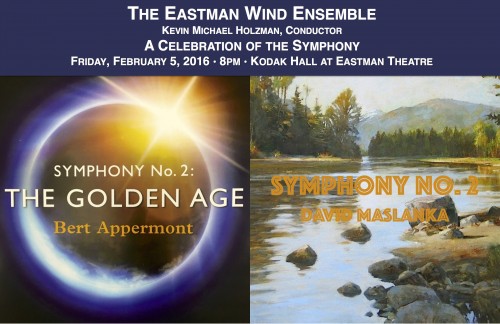By Kevin Holzman
On Friday, February 5, 2016 at 8 p.m. in Kodak Hall at Eastman Theatre, The Eastman Wind Ensemble, conducted by Kevin Holzman, presents A Celebration of the Symphony.
Far from an outdated genre, the symphony continues to thrill and inspire musicians and audiences across the world. The power of this genre is in its variety, its ability to not just present and explore a wide variety of topics and narratives, but to take the performer and audience on a trans-symphonic journey through the development of those ideas across multiple movements. In selecting these two works, I aim to present two monumental examples of the modern symphony for wind ensemble which, while each displaying the vital and recognizable characteristics of this historic genre, are completely different in terms of their sound worlds and constructions. David Maslanka’s Symphony No. 2 (1986) is arguably the first romantically proportioned and conceived symphony for the wind ensemble. Maslanka, the most prolific wind ensemble symphonist, currently has in his oeuvre seven symphonies for wind ensemble, ranging from one to five movements, with performance times spanning 28 minutes to 1 hour and 15 minutes. I asked David if he would be willing to provide an updated program note for our performance, and this was his reply:
Nearly thirty years have passed since the premiere of Symphony No. 2, the first of my seven symphonies for wind ensemble. In that time I have come to recognize that issues of
transformation are at the heart of my work, initially my personal issues of loss, grief, and rage, then knowing that my own change is the start for some element of outward movement, for change in the world. This is a long, slow process, but it is the requirement of our time. The crux of Symphony No. 2 is the river metaphor of the second movement crossing over to the other side…death, yes, but also movement away from ego/self and toward compassion.
Everyone knows that we are living in a seriously dangerous time. For me, Symphony No. 2 was my first awareness in artistic terms that this is the case. Nearly sixty years ago African writer Chinua Achebe wrote the renowned novel, Things Fall Apart. Chronicling the destruction of one life he hit upon what we must do to regain our balance: return to our deepest inner sources for sustenance and direction; return to the tradition of the art community: people selected and set apart to dream for the community as a whole. If art is worth anything it is this: it brings us back to dream time and the inner voice. It lets the heart speak, giving us answers that we cannot reach in any other way. This is why we make music. – David Maslanka, 2016
It was through my correspondence with David that I discovered Bert Appermont’s Symphony No. 2, “The Golden Age” (2011), a symphony modeled explicitly on the epic symphonies of Gustav Mahler and Dmitri Shostakovich. Appermont’s symphony demonstrates an even further expansion of the possibilities the wind ensemble offers modern symphonists, and very much reflects the traditions of European romantic symphonists. As with Maslanka and generations of other symphonists, Appermont utilizes the symphony as a means to portray both the world around him and the inner struggle inherent in navigating this world. Part of his program note reads:
The title of this symphony serves as a metaphor for the modern world and, as such, has a certain ironic undertone. To what extent has humankind achieved its divine potential? How did the world reach the state it is in today? And whatever happened to that Golden Age in which we may once have lived?
The duality of human existence is interwoven in all four parts and runs like a thread through the entire symphony. Even in the darkest depths there is always a glimmer of light; in joy is sewn the seed of vexation; and in doubt is contained the germ of hope.
So it is that every answer provokes a new question and the music itself is an expression of the unending momentum of the universe- like a perpetual motion machine that turns in even tighter, more complex spirals of existence.
We have lost touch with the higher beings. Yet there is more between heaven and earth than we can possibly grasp. Will humankind find its way back to the Golden Age? Or will it continue to struggle through a seemingly free and happy world of insanity? – Bert Appermont, 2011
I hope that through this performance of these works, the symphony for wind ensemble begins to again receive the attention it deserves. In a world in which we so often feel so disconnected from one another, the symphony brings both performers and audience members together in a way few experiences today can. The possibilities are endless for symphonic composition within this still (relatively) new ensemble, and I am extremely grateful to have you join me for this very small taste of these possibilities.



